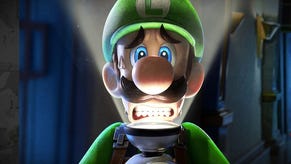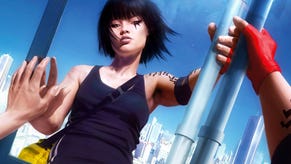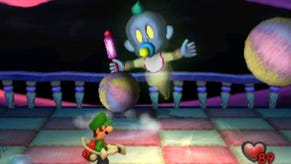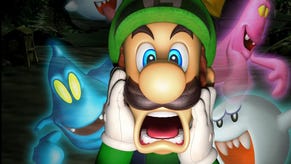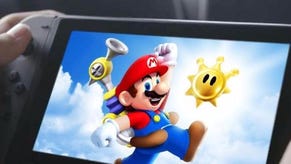Luigi's Mansion
Review - Miyamoto's first GameCube offering is a joy for fans, but can ghostbusting really work as an entire game?
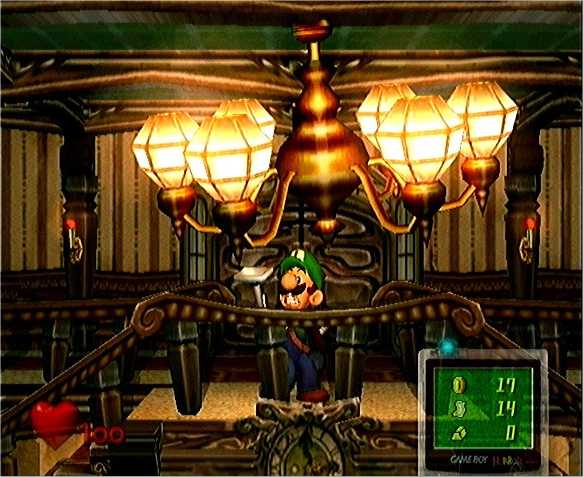
The Phantom Menace
The NES had Super Mario Bros. The SNES had Super Mario World. The N64 had Super Mario 64. Traditionally Mario sells the console and then Nintendo drip-feeds gamers with offerings from its other major franchises, but this time Mario's late to the party. So late in fact, he hasn't even turned up in Japan yet. Nintendo's diminutive console needs something to sell it, and the closest thing to a Mario game we have for now is Luigi's Mansion, brainchild of legendary designer Shigeru Miyamoto. Is it enough? The premise is extremely simple. By way of a peculiar stroke of luck, Luigi has won a mansion in a competition he never even entered, and agrees to meet his brother Mario there for a celebration. Unfortunately, after wandering aimlessly through a spooky forest, our hero discovers that his mansion prize is little more than an elaborate trap, and headstrong Mario has already fallen victim. Teaming up with local oddball Professor E. Gadd, Luigi vows to rid the mansion of its ghostly inhabitants and rescue his brother. The game is a bold departure from previous Mario Brothers titles. Unlike his bouncy brother, Luigi doesn't jump, bop people on the head or throw fireballs. He doesn't fly, and he doesn't collect stars. Well, only once. Luigi's spooky adversaries are almost infallible, susceptible to nothing but the quirky Prof's modified vacuum cleaner, the Poltergust 3000. Using the pressure-sensitive left and right shoulder buttons to blow and suck at the desired rate, Luigi can gobble up ghosties and bag the Boos, before returning to the Prof's lab to turn them into portraits for the gallery.
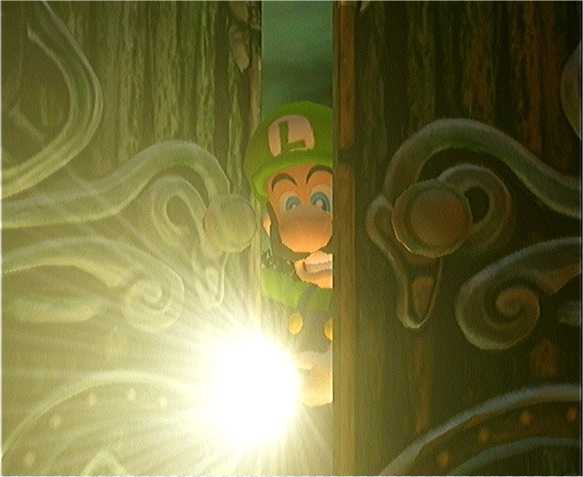
Otherworldly
The mansion itself is huge and sumptuously detailed, revealed piece by piece as Luigi feels his way around with a torch. The pseudo 3D world created for the game is a terrific achievement, viewed from the front instead of a roving camera, rich with consistently delicate design and minutiae, real-time lighting and shadows, and with almost total interaction permitted. Luigi can suck cloths from tables, rattle desks and uncover untold treasures by experimenting on different things with his Poltergust. A steady stream of dust pours off worthless items, and coins, gold bars, jewels and even the odd bit of paper money empty from many of the others. The mansion is laid out across several floors, and Luigi moves between these as he finds keys, keeping track of the rooms he's cleared and which doors he has keys for using his GameBoy Horror, another of E. Gadd's devices. Rooms house either a collection of smaller ghosts or one of the larger spectres to be bound in the Professor's gallery, and each has a weakness which allows you to see their heart. The Poltergust can latch onto hearts, but ghosts aren't eager to give them up. Watching a ghost's behaviour allows you to unravel the puzzle of how to capture them, and this can mean anything from distracting them from their meal to dazzling them with melody. The props, clues and series in-jokes are easy to find and fun to play with. Luigi himself is wonderfully detailed. He can tiptoe, trot and scamper quickly, and as he stands in the dark you can see him breathing nervously, his eyes darting this way and that and his little hands trembling. Aw. Apart from sucking the not-so-living daylights out of the furniture and his surroundings, the petrified plumber can also do a bit of damage with his nozzle. Several elemental tokens are spread throughout the game, and upon finding these Luigi can start spitting water, fire and even ice from his Poltergust, with a steady supply of each available from taps, candles, ice buckets and other logical sources. Some ghosts need softening up with an element before vacuuming, which is a nice touch.
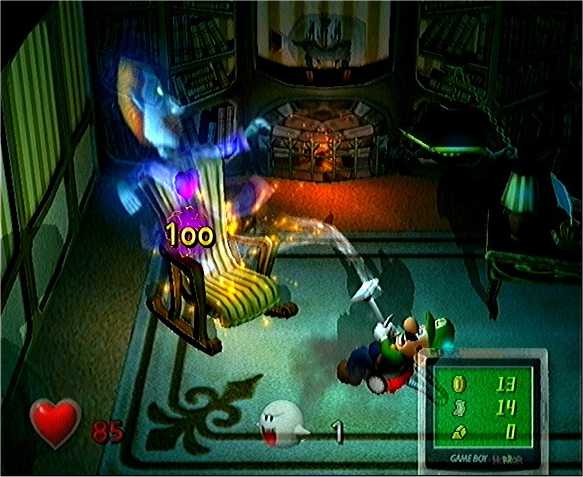
Whoops...
Shortly after embarking on his quest, Luigi comes across an odd room with a secret lever, and before he knows what he's doing the game's true bad guys, the Boos, have woken from their slumber and raced off to terrorize the house. Apart from vacuuming up the resident nasties of each area, Luigi also has to use his GameBoy Horror's Boo Radar to locate the wily tricksters, who aren't so susceptible to the Poltergust's confinement beam, and dart between rooms to make the player's life even more difficult. The game is split into several rough areas, each culminating in a boss encounter, but as these are spread all over the house the structure is largely academic. These boss encounters are suitably memorable, from the irate baby a few minutes in to King Boo himself, if he's still man enough to face you. After defeating a boss ghost the Poltergust needs emptying, so Luigi heads back to E. Gadd's lab to turn the bad guys into portraits using the Ghost Portrificationizer, before heading back into the mansion and finding some more spectres. Luigi's activities take him all over the place and keep the player thinking. The puzzles are never too hard, nor too easy, and utilize all areas of the control system. Along the way, Luigi catches fleeting glimpses of a greater adversary and his endangered sibling, both literally, through a secret tunnel in a murky place, and metaphysically, through the helpful psychic Madame Clairvoya, who will analyse a handful of things stripped from Mario during his passage to imprisonment if Luigi can find them. The mansion and tasks form an extremely congruous adventure, however all-over-the-place the game may feel, and little diversions and submissions - like the collection of dropped pearls to make better picture frames - add classic Nintendo diversity to the already unique atmosphere.
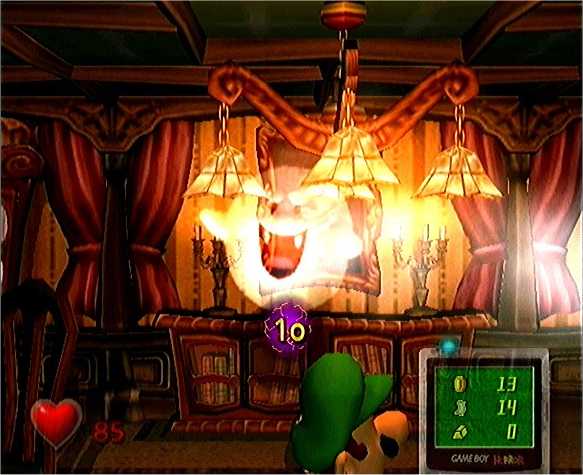
Fright Night
Speaking of atmosphere, one of the game's finest assets is its soundtrack. Although the haunted mansion theme is typically good, and whistled nervously by the game's star as he trundles down hallways avoiding phantom bats and rats, the little side pieces make all the difference. The game is eerie and uncomfortable, augmented superbly by the composers, and yet the end product still manages to look and sound like a Mario adventure. And although devoid of traditional voice acting, all of the characters - including the ghosts - have their own eerie mutterings, and if you hammer the action button without facing an object Luigi yells for Mario. Poor feller. That said, many of the game's locations have a tendency to look flat, and the first person view through Luigi's GameBoy Horror - useful for analysing weaknesses and spotting lesser ghosts - is somewhat disorientating. The engine doesn't lend itself particularly well to first person exploring, presumably why our hero cannot move in this view, and the perspective is definitely wrong. Despite these setbacks though, the game is generally pleasant to look at, with reflective surfaces and intricate detail all over the shop. Even minor characters like Toad, who shows up around the house now and then to save your progress, receive a generous amount of attention, and the game's bad guys are all unmistakably semi-transparent floating spectres. Sadly Luigi's Mansion is neither terribly challenging nor particularly long. Although I had a bit more trouble with the PAL release of the game than I did with the Japanese version which I played in September, there really is no point in the game where reasonably seasoned players will struggle, and the many vases and chests around the house are loaded with health-replenishing hearts and so forth, which respawn if Luigi is running on empty. Although this is something of a compliment to the intuitive control system, finishing the game takes roughly five hours if you take it at a leisurely pace, and although coin-collectors are rewarded and Miyamoto has added a few extra bits and bobs to uncover since the Japanese and American releases, this isn't going to last you more than a weekend. Furthermore, despite the PAL60 support in the European Cube hardware, the game runs at a borderless 50Hz. It looks nice, but it's not as smooth as the NTSC versions, even if load times are unheard of and slowdown is something of a rarity.
Conclusion
Luigi's Mansion is a delightful little game, instantly appealing to anybody with more than a passing interest in its heritage, but it isn't the GameCube equivalent of those platform classics I name-checked at the start of the review. A competent, atmospheric adventure and truly a new direction for the characters, but at this length it simply isn't worth the £35, let alone the cost of the console. If Miyamoto's vision of shorter games more often is to become reality, then the pricing structure will need serious adjustment...


